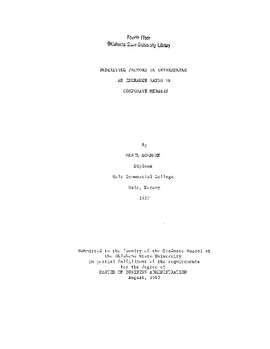| dc.contributor.advisor | Jackson, James F. | |
| dc.contributor.author | Holmsen, Aksel | |
| dc.date.accessioned | 2016-02-05T15:45:09Z | |
| dc.date.available | 2016-02-05T15:45:09Z | |
| dc.date.issued | 1965-08 | |
| dc.identifier.uri | https://hdl.handle.net/11244/27644 | |
| dc.description.abstract | Scope and Method of Study: The purpose of this study is to examine the methods of evaluation in industrial mergers from the viewpoint of management and the extent to which premiums or discounts were given the acquired corporation relative to the principal evaluation technique found of major importance in determining the price. In determining the degree of consideration given to the various evaluation methods, the various ratios computed between the merged companies, for the different evaluation techniques, were divided by the ratio of exchange The extent to which premiums or discounts were given the selling firms was obtained by taking the ratio for the evaluation technique of prime consideration between the two merging companies and dividing this into the exchange ratio. Then, by multiplying this by one hundred, the percentage of premium or discount is obtained. | |
| dc.description.abstract | Findings of Study: It was found in this group of companies under study that "Common Stock Prices" was the evaluation technique of major importance Even in cases where the relationship existing between the corporations' common stock prices is not the principal factor, it appears to have some influence. The other factors of importance in determining the exchange ratio were found to be, in their order of importance: earnings, balance sheet items, dividends and the price-earnings ratio. | |
| dc.description.abstract | Corporations enter the merger situation under the assumption that special benefits will develop as a result of the combined efforts. Hypothesis number two suggested that in order for an agreement to take place, the acquired company should receive some premium, being a contributing part to the assumed future benefits. | |
| dc.description.abstract | In 80% of the mergers analyzed, based on the most important evaluation technique, the surviving corporation paid a premium to the stockholders of the acquired corporation. The average premium paid to the selling stockholders was about 6%. In the very few instances when the acquisition was completed at a discount there was an obvious reason for not paying more. The percent of premium seems then to depend on the optimism of the merging firms. | |
| dc.format | application/pdf | |
| dc.language | en_US | |
| dc.rights | Copyright is held by the author who has granted the Oklahoma State University Library the non-exclusive right to share this material in its institutional repository. Contact Digital Library Services at lib-dls@okstate.edu or 405-744-9161 for the permission policy on the use, reproduction or distribution of this material. | |
| dc.title | Underlying factors in determining an exchange ratio in corporate mergers | |
| osu.filename | Thesis-1965R-H753u.pdf | |
| osu.accesstype | Open Access | |
| dc.type.genre | Master's Report | |
| dc.type.material | Text | |
| thesis.degree.discipline | Finance | |
| thesis.degree.grantor | Oklahoma State University | |
